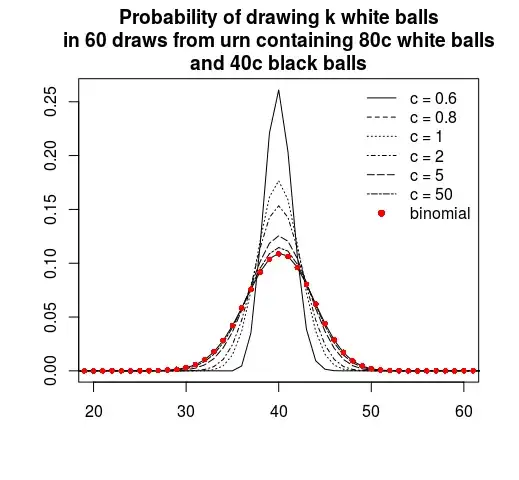The simplest way to answer this question is just to state the probability mass function that occurs in the general case, and look at its properties with respect to $N$ (i.e., look at the corresponding likelihood function for the parameter $N$). The probability mass function for the hypergeometric distribution is:
$$\text{HG}(k|N,K,n) = \frac{{K \choose k} {N-K \choose n-k}}{{N \choose n}} \overset{N}{\propto} \frac{(N-K)!(N-n)!}{N!(N-K -n + k)!}.$$
It is possible to investigate all sorts of properties of the above function, and there are all sorts of things we could potentially say about it. One interesting property of this probability mass function is that it is quasi-concave in $N$ (see below). From this result the MLE for that parameter is:
$$\left \lceil{\tfrac{nK}{k}-1}\right \rceil \leqslant \hat{N} \leqslant \left \lfloor{\tfrac{nK}{k}}\right \rfloor.$$
(This gives a unique solution if $\tfrac{nK}{k} \notin \mathbb{N}$, and it gives two solutions if $\tfrac{nK}{k} \in \mathbb{N}$.) Hence, we see that the MLE estimates $N$ in a way that roughly equalises $\tfrac{n}{N} \approx \tfrac{k}{K}$, with convergence as $n \rightarrow \infty$. There is probably plently more we could say about this distribution. It would be interesting to look at what happens once you combine it with various Bayesian priors on $N$. I will leave it to others to give other insights, but the above seems like an interesting aspect of the distribution to me.
Proof of quasi-concavity: For simplicity, we denote $\phi(N) = \text{HG}(k|N,K,n)$ and consider the other variables to be implicit (fixed) values. We can then write:
$$\begin{equation} \begin{aligned}
\frac{\phi(N+1)}{\phi(N)} - 1
&= \frac{(N-K+1)(N-n+1)}{(N+1)(N-K-n+k+1)} - 1 \\[6pt]
&= \frac{(N-K+1)(N-n+1) - (N+1)(N-K-n+k+1)}{(N+1)(N-K-n+k+1)} \\[6pt]
&= \frac{(n-k)(N+1)-n(N-K+1)}{(N+1)(N-K-n+k+1)} \\[6pt]
&= \frac{(nN+n-kN-k)-(nN-nK+n)}{(N+1)(N-K-n+k+1)} \\[6pt]
&= \frac{nK-k(N+1)}{(N+1)(N-K-n+k+1)} \\[6pt]
&= \frac{\tfrac{n}{k/K}-(N+1)}{k(N+1)(N-K-n+k+1)}. \\[6pt]
\end{aligned} \end{equation}$$
Hence, we have:
$$\text{sgn} \Big( \phi(N+1)-\phi(N) \Big)
= \text{sgn} \Big( \frac{\phi(N+1)}{\phi(N)} - 1 \Big)
= \text{sgn} \Big( \tfrac{n}{k/K} - (N+1) \Big).$$
Hence, we see that the mass function is increasing for $N+1 < \tfrac{n}{k/K}$ and then decreasing for $N+1 > \tfrac{n}{k/K}$. This means that the probability mass function is quasi-concave in $N$.
